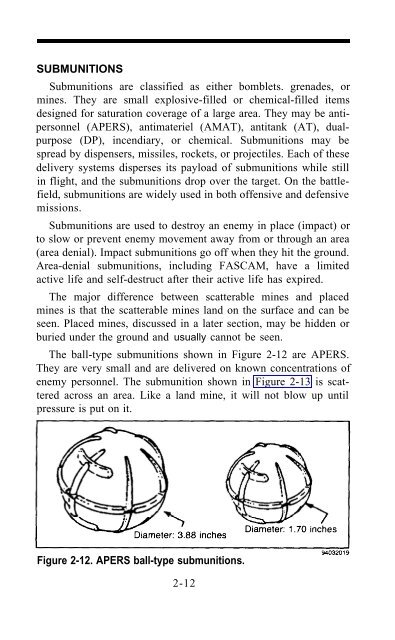FM 21-16 UXO Procedures
FM 21-16 UXO Procedures
FM 21-16 UXO Procedures
Create successful ePaper yourself
Turn your PDF publications into a flip-book with our unique Google optimized e-Paper software.
SUBMUNITIONS<br />
Submunitions are classified as either bomblets. grenades, or<br />
mines. They are small explosive-filled or chemical-filled items<br />
designed for saturation coverage of a large area. They may be antipersonnel<br />
(APERS), antimateriel (AMAT), antitank (AT), dualpurpose<br />
(DP), incendiary, or chemical. Submunitions may be<br />
spread by dispensers, missiles, rockets, or projectiles. Each of these<br />
delivery systems disperses its payload of submunitions while still<br />
in flight, and the submunitions drop over the target. On the battlefield,<br />
submunitions are widely used in both offensive and defensive<br />
missions.<br />
Submunitions are used to destroy an enemy in place (impact) or<br />
to slow or prevent enemy movement away from or through an area<br />
(area denial). Impact submunitions go off when they hit the ground.<br />
Area-denial submunitions, including FASCAM, have a limited<br />
active life and self-destruct after their active life has expired.<br />
The major difference between scatterable mines and placed<br />
mines is that the scatterable mines land on the surface and can be<br />
seen. Placed mines, discussed in a later section, may be hidden or<br />
buried under the ground and usually cannot be seen.<br />
The ball-type submunitions shown in Figure 2-12 are APERS.<br />
They are very small and are delivered on known concentrations of<br />
enemy personnel. The submunition shown in Figure 2-13 is scattered<br />
across an area. Like a land mine, it will not blow up until<br />
pressure is put on it.<br />
Figure 2-12. APERS ball-type submunitions.<br />
2-12

















